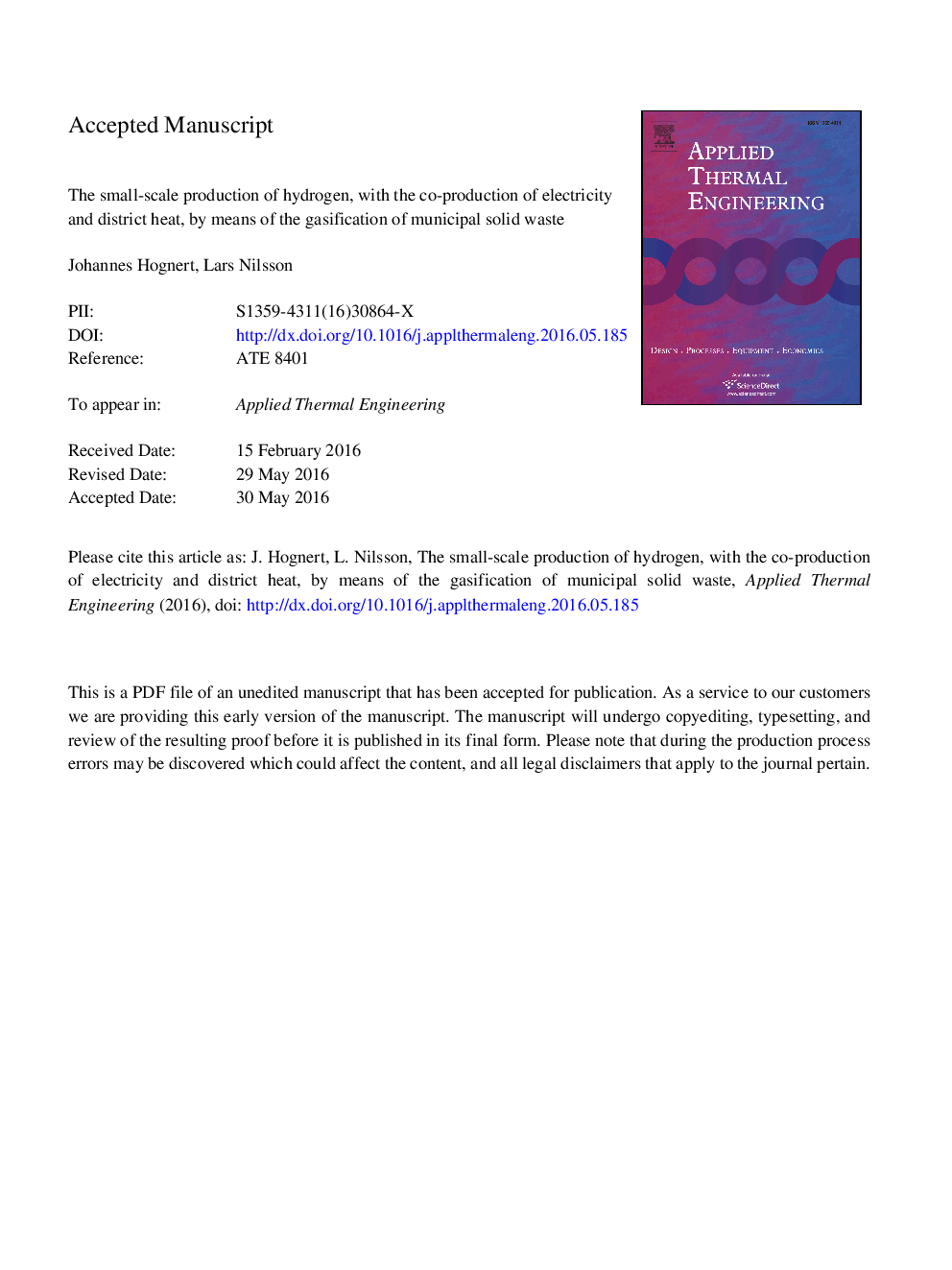| کد مقاله | کد نشریه | سال انتشار | مقاله انگلیسی | نسخه تمام متن |
|---|---|---|---|---|
| 7047413 | 1457122 | 2016 | 9 صفحه PDF | دانلود رایگان |
عنوان انگلیسی مقاله ISI
The small-scale production of hydrogen, with the co-production of electricity and district heat, by means of the gasification of municipal solid waste
ترجمه فارسی عنوان
تولید مقادیری از هیدروژن با همکاری تولید برق و حرارت منطقه با استفاده از گازسیون زباله های جامد شهری
دانلود مقاله + سفارش ترجمه
دانلود مقاله ISI انگلیسی
رایگان برای ایرانیان
کلمات کلیدی
هیدروژن، گازسیون، هدر، حرارت منطقه،
ترجمه چکیده
کاهش استفاده از سوخت های فسیلی و افزایش بازیافت زباله، دو چالش مهم برای یک جامعه پایدار است. سوخت های فسیلی به گرمایش جهانی کمک می کنند در حالی که زباله ها باعث آلودگی زمین، آب و هوا می شوند. سوخت های جایگزین و سیستم های مدیریت زباله نوآور برای حل این مسائل مورد نیاز است. در این مطالعه، یک فرآیند گازسیون با سوخت زباله های جامد شهری، به عنوان یک گیاه گرما برای تولید هیدروژن، برق و حرارت منطقه یکپارچه شده است. کل سیستم، که شامل یک راکتور گازسیون، کارخانه حرارت، چرخه بخار، جذب نوسان فشار، توربین گاز و کمپرسورها بود، در مایکروسافت اکسل مدل سازی شد و تعادل انرژی سیستم حل شد. داده های ادبیات علمی هنگام تنظیم مقادیر گرما و جرم در فرایند گازسیون و نیز ارزیابی ترکیب گاز سنتزی مورد استفاده قرار گرفت. تخصیص انرژی محصولات به دست آمده در این فرایند 29 درصد هیدروژن، 26 درصد برق و 45 درصد گرمای منطقه است. یک نتیجه قابل توجه از مطالعه، بهره وری انرژی بالا (88٪) در طول دوره سرد سال است که حرارت تولید شده در این سیستم برای حرارت منطقه مورد استفاده قرار می گیرد. این سیستم همچنین بهره وری رقابتی انرژی (56.5٪) را در طول سال نشان می دهد.
موضوعات مرتبط
مهندسی و علوم پایه
مهندسی شیمی
جریان سیال و فرایندهای انتقال
چکیده انگلیسی
Reducing the use of fossil fuels and increasing the recycling of waste are two important challenges for a sustainable society. Fossil fuels contribute to global warming whilst waste causes the pollution of land, water and air. Alternative fuels and innovative waste management systems are needed to address these issues. In this study a gasification process, fuelled with municipal solid waste, was assumed to be integrated into a heat plant to produce hydrogen, electricity and district heat. A whole system, which includes a gasification reactor, heat plant, steam cycle, pressure swing adsorption, gas turbine and compressors was modelled in Microsoft Excel and an energy balance of the system was solved. Data from the scientific literature were used when setting up the heat and mass balances of the gasification process as well as for assessment of the composition of the syngas. The allocation of energy of the products obtained in the process is 29% hydrogen, 26% electricity and 45% district heat. A significant result of the study is the high energy efficiency (88%) during the cold period of the year when the produced heat in the system is utilized for district heat. The system also shows a competitive energy efficiency (56.5%) all year round.
ناشر
Database: Elsevier - ScienceDirect (ساینس دایرکت)
Journal: Applied Thermal Engineering - Volume 106, 5 August 2016, Pages 174-179
Journal: Applied Thermal Engineering - Volume 106, 5 August 2016, Pages 174-179
نویسندگان
Johannes Hognert, Lars Nilsson,
